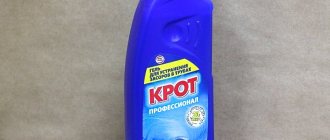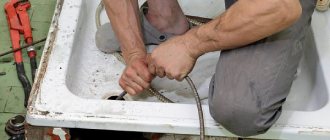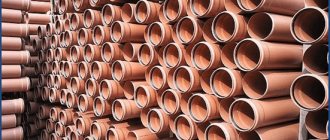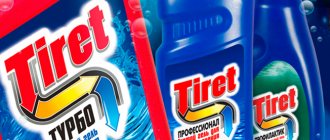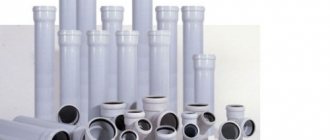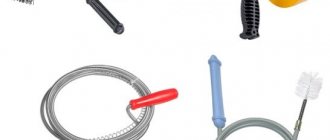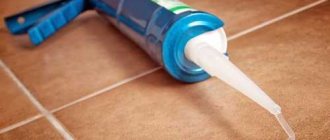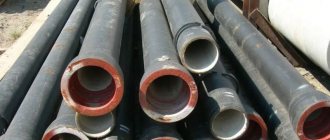Mole pipe cleaner has been popular for decades.
With its help, it is possible to maintain the functionality of the household by successfully combating blockages that occur in pipes. At the same time, the relevance of the Mole cleaning product remains today, which has not been affected by changes that have occurred with sewer pipes and wastewater. The former have mostly become plastic, and the latter have changed their chemical characteristics, but the substances included in the famous product still cope with their task.
Purpose and scope
Being an alternative to plumbing cable, traditionally used for cleaning pipelines, the “Mole” cleaner is also used as a means of preventing, with systematic preventive use, the formation of mud plugs that interfere with the normal functioning of sewer lines.
“Mole” is actively used not only in everyday life of an ordinary house or apartment, but also:
- trade and catering enterprises;
- dry cleaners and laundries;
- medical institutions;
- hotels;
- beauty salons, etc.
Composition of the cleaning product
The active components of the “Mole” cleaner, regardless of the form of release, are alkalis, which are responsible for dissolving fats:
- Sodium hydroxide (caustic soda or caustic soda), the concentration of which is about 40 - 60%.
- Potassium hydroxide in a concentration of 5 – 10%.
The percentage of active ingredients determines the effectiveness of the drug against blockages. As a rule, cleaners labeled “Turbo” / “Tornado” / “Strengthened” / “Ultra” (see photo) effectively cope with blockages of almost any degree of complexity.
In addition to alkalis, the list of chemical ingredients invariably includes:
- Modified ethylenediaminetetraacetic acid (5 - 10%), softening water and softening solid organic inclusions.
- Non-ionized surfactants (surfactants) in concentrations up to 10%, activating a chemical reaction.
- Distilled water (5 - 25% - in liquid and gel preparations).
Some varieties of “Mole” contain flavorings that ultimately do not affect the cleaning result.
The manufacturer must include a description of the ingredient composition of the cleaner on the product packaging.
Types and forms of release of the drug "Mole"
"Mole" is available in three types:
- gel;
- liquid;
- dry (in the form of powder or granules).
The packaging format is determined by consumer demand. The most popular segment is aimed at the average consumer:
- For powder products, these are sachets weighing 100-250 g, designed for one-time use, or packages weighing 1 kg for multiple use.
- For liquid and gel - containers with a volume of 250 ml. or 1 l.
For commercial facilities, the cleaner is usually purchased in concentrate format in containers of 5 - 10 liters.
Gel
Gel-like products, characterized by a thick translucent consistency, are considered the most economical. Slowly spreading over the surface, the gel envelops the surface of the pipe, cleaning it.
Gel cleansers are considered less effective compared to other types, but the most gentle on human health.
It is preferable to use Mole Gel to remove plugs located shallowly in the sewer system and to prevent the deposition of dirt inside the pipeline.
Liquid
Liquid “Mole,” although it belongs to the cheapest category, is considered the most effective against deep-seated blockages.
The only negative is the need to be careful when working with the chemical. Being highly concentrated, it causes a chemical burn if it comes into contact with the skin.
Powder and granules
Dry “Mole” is available in one of two formats: powdered or granular. Granules generally contain more active ingredient. But both types quickly and well cope with severe blockages.
Some powders are a concentrate that requires prior dissolution in water.
What are the differences between different types?
When choosing one type or another, you need to take into account the specific characteristics of each:
- The concentration of the active substance, on which the quality of pipeline cleaning depends.
- Period of action: from several minutes to 3 hours.
- Method of application.
Distinctive features
There are two main types of compositions for cleaning sewer pipes - based on acids or alkalis, each of them has certain advantages and disadvantages. The popularity of the most effective Israeli-made Pothan product, as well as the neutrality of alkalis with respect to metals, speaks in favor of alkaline reagents. Using Mole for sewer pipes has the following pros and cons:
- Alkali does not have a destructive effect on polymer materials and a wide range of metals, therefore it can be used with the greatest safety in multi-storey buildings of old construction with sewerage and permanent risers made of cast iron.
- The time of use of the product depends on the manufacturer and form of release, gel and powders act within 20 - 30 minutes, for liquids to work it takes 1.5 - 3 hours. In case of severe contamination, when using the Mole product, cleaning the pipes takes a longer period of time; it is recommended to keep the composition in the pipeline for up to 8 hours.
- Unlike potent drugs like Pothan, which can destroy polymer pipes and the room with its use requires good ventilation, Mole is less aggressive and can work without additional ventilation with minimal negative impact on the sewer pipeline.
- Mole from different manufacturers has an excellent percentage of caustic soda; it is clear that the drug with its high percentage composition is most effective.
- The product is inexpensive and the price is several times lower than its foreign analogues, which is its significant advantage.
Rice. 6 Application of the product
Why do clogs occur in pipes?
The main reason for the formation of blockages is the tortuosity of the pipeline. So most of them are formed in siphons and at turns. However, pipes often become clogged in straight sections of the sewer system, which are characterized by an uneven internal surface:
- roughness of internal walls;
- protrusion of seals at the junction of pipeline elements: rubber gaskets, tow, etc.
Clinging to uneven surfaces, fats, food debris and other solid household waste (hair, fish scales, etc.) are layered on top of each other and tightly glued into a poorly soluble mass, blocking the gap in the pipe and emitting an unpleasant rotting odor.
Comments
April 20, 2017
Maxim
Hello! I have a question: the sewer in the bathroom is clogged, how are the drainage pipes from the washing machine and the bathroom connected into one sewer line, the water no longer flows at all, do you think the Mole product will help against clogging in such a situation?
0 0 Reply
April 20, 2017
Mikhail (o-trubah.ru) ➜Maxim
The Mole and its analogues may well help in this situation. But you need to take into account that when used, the product gets into the pipe and moves until the first blockage, which then destroys it. Ideally, you should pour a portion of the reagent into each drain hole in turn, then wait the required time and flush the system. But for greater effect, it is still worth combining dry cleaning with mechanical removal of contaminants.
1 0 Reply
April 20, 2017
Kamalitdin
A visible thick layer of stone was formed. The exit passage is very narrow. Conventional remedies do not help, that is, they do not split the stone.
1 0 Reply
April 20, 2017
Mikhail (o-trubah.ru) ➜Kamalitdin
In your case, you need granular products that will effectively remove lime deposits. Conventional compounds are unlikely to help here, so you should purchase a specialized pipe cleaner and use it in strict accordance with the instructions.
1 0 Reply
April 21, 2017
Vladimir
Hello, I am interested in a product for cleaning sewer pipes in a restaurant: from fat deposits, from odor, from organic matter. I heard that there are some bacteria that feed on this. How harmless are they to people? If this is nonsense, then chemicals...
0 0 Reply
April 21, 2017
Mikhail (o-trubah.ru) ➜Vladimir
Bacteria that decompose organic matter into mineral components, gases (hydrogen sulfide, carbon dioxide) and water really exist. But they are not used for cleaning pipes, but for recycling wastewater in biological treatment plants or in septic tanks. So for pipes you need to use professional chemical compounds that will dissolve fatty deposits.
1 0 Reply
April 25, 2017
Svetlana
Hello! I bought products to dissolve sewer pipe contaminants. Biysk. Do you know if it can be used to clean plastic pipes?
0 0 Reply
April 25, 2017
Mikhail (o-trubah.ru) ➜Svetlana
The manufacturer does not indicate any restrictions on the use of this product, so in theory it is possible. In addition, reviews from those who used the composition confirm this. The main thing is to follow the instructions and remember safety precautions!
0 0 Reply
Advantages and disadvantages of "Mole"
The “Mole” cleaner has a number of advantages in comparison with Russian and imported analogues:
- Highly effective in dealing with blockages of varying degrees of complexity.
- Possibility of cleaning even hard-to-reach areas of the pipeline.
- Performance.
- Simplicity and ease of use.
- No dirt that cannot be avoided when working with plumbing cable.
- Affordable price category.
There is only one drawback - the need to be careful when using the drug. However, careful precautions must be taken when handling any chemical.
Precautionary measures
The ingredients included in Krot are not safe for humans. Their contact with the skin or mucous membranes provokes a chemical burn, and contact with the eyes leads to loss of vision. The caustic hydrogen sulfide released during the chemical reaction causes suffocation.
Compliance with passive safety measures will help avoid health problems:
- Carry out work only with protective rubber gloves.
- It is better to wear a mask or respirator on your face.
- It is recommended to protect your eyes with special glasses.
If troubles cannot be avoided, you must:
- Wash areas in contact with the chemical with a weak solution of boric acid and sufficient running water. If necessary, seek help from a doctor.
- If poisoned, drink at least 2 liters of water and immediately go to the clinic.
Compliance with safety measures
Since the main components of the drug are caustic substances, the following rules should be followed when working:
- When using "Mole", sewer cleaning is carried out exclusively with protective gloves.
- If the drug gets on your skin, you should immediately rinse it with water.
- If redness appears, the affected area must be treated with any product with a disinfecting effect.
- If it gets into your eyes, rinse them immediately and go to the hospital.
If the “Mole” sewer pipe cleaner gets into your stomach, you should immediately call emergency medical services. Before doctors arrive, the victim needs to drink plenty of fluids.
Methods of application
The manufacturer indicates how to use this or that product on the label.
- It is advisable to warm up the sewer first by pouring a small amount of hot water into it.
- Shake the liquid or gel product before use without removing the lid.
- 200 - 250 ml of cleaner is poured into the sink drain hole or 100 - 150 g is poured. powder.
- If using Mole powder, slowly pour 200 ml of water on top.
- The time specified by the manufacturer is waited.
- If the blockage is serious, it would be a good idea to run a plunger for a couple of minutes, first pouring 2 liters of hot water into the sink.
- Finally, the pipeline is washed with running water for 5–10 minutes.
If the sewer is severely clogged and it was not possible to clear it the first time, it is recommended to repeat the operation again, increasing the period of exposure to the drug.
Tips for use
Throughout the production of the drug, consumers have accumulated extensive experience and numerous recommendations to improve efficiency.
- Before using the product, you should warm up the sewer. To do this, you can run hot water into the system for a few minutes.
- When the 90 minutes allotted for the product to act have ended, you must pour at least six glasses of water into the drain and use a plunger. It will help granules or liquid to get into the deepest places of the system and relieve it of blockages.
- When "Mole" is used, sewer cleaning should not exceed the time specified by the manufacturer. This will not enhance the effect of the drug, but, on the contrary, may cause destruction of the surface of sewer parts.
- You can achieve good sewer flushing when a lot of water is poured into the system. Ideally it will be hot.
Using the proven drug “Mole” to clean the sewer system, which allows you to get rid of blockages, will help you achieve the desired result within a short period of time. The components of the composition can easily cope with various types of contaminants. A “mole” for sewer pipes will allow you to restore the functionality of the system in the shortest possible time.
How to prepare a homemade analogue of “Mole”
Using familiar products in everyday life, you can prepare an analogue of “Mole” at home:
- Soda and vinegar.
250 g of baking soda (if available, then caustic) soda is poured into the drain and 100 ml of table vinegar is poured. Foaming will mark the reaction; to enhance the effect, it is recommended to close the drain hole tightly. After 10 - 15 minutes, the sewer is washed first with hot and then with cold water.
On a note! Caustic soda is not recommended for use in combination with enameled plumbing fixtures, because it inevitably damages the enamel.
- Soda and salt.
200g of salt and 100g of soda are mixed and dissolved in 200 ml of water. The resulting solution is poured into the pipe and left for 15–30 minutes. Then you will have to work hard with a plunger for 5–10 minutes and flush the drain with running hot water for 5 minutes.
On a note! It is doubtful that folk remedies will cope with complex blockages, but these recipes are entirely suitable for preventing their occurrence. The components included in the composition will prevent the deposition of fats in the pipes.
What to consider when choosing the type of product: useful tips
The choice of Mole as a pipe cleaner depends on the frequency of blockages in the system and where they occur. For prevention, a liquid product is sufficient. But it does not guarantee TEXT_LINKS removal of a large blockage.
Therefore, it is recommended to keep several types of Moles for pipes in your home arsenal.
The first indicator is the volume of packaging. For one-time use, you can take several bags of granules. This will remove fat plugs, but will make prevention more difficult. The granules or powder are concentrated in only one place in the pipeline or siphon, which narrows the area of effect.
Gel Mole for pipes is a universal remedy. In small quantities it prevents the formation of dirt plugs and can be used for global cleaning.
An additional plus is the sealed packaging. Once the lid is opened, the shelf life does not decrease.
Recommendations for use in different places of the sewer system:
- Cleaning siphons - granules or powder. They have an increased time of action on the blockage, without passing further along the highway.
- Pipe joints. Here you can apply the gel. It is evenly distributed over the entire surface of the highway, concentrating in places with the largest volume of blockages.
- Hard-to-reach pipeline areas. For them, you can first use a gel, and then a liquid for prevention.
You cannot use a bottle of Mole gel on the farm. Some of the chemical components settle on the walls and can be mixed with other liquids and bulk compositions. Simply flushing will not solve the problem.
Soda and vinegar for cleaning pipes: 6 ways to clean drains at home Various reasons can cause blockages in pipes. To combat the problem, various store-bought products are used, for example, Mole. However, you can get rid of it using means that can be found in...
For the sewer system of an apartment or small private house, you can take 1 liter bottle of Mole gel and several bags of granules. The first is used to prevent or remove small plugs. Using granules, you can effectively clean bathroom and kitchen sink siphons.
